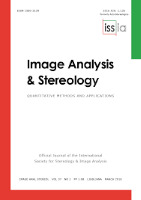
Image Analysis & Stereology
Scope & Guideline
Bridging Disciplines Through Cutting-edge Image Analysis
Introduction
Aims and Scopes
- Image Segmentation and Analysis:
This area encompasses methodologies and algorithms designed to segment and analyze images, particularly in biomedical applications. Techniques like active contours and deep learning approaches are frequently explored. - Statistical Methods in Imaging:
The journal emphasizes the use of statistical models to interpret and analyze image data. This includes probabilistic approaches and density estimation techniques, which are crucial for robust image analysis. - Morphological Image Processing:
Research in this scope focuses on morphological methods for image processing, including the application of mathematical morphology in various domains such as material sciences and biology. - Multiscale and Multimodal Imaging:
This area highlights the integration of multiscale and multimodal imaging techniques, enabling comprehensive analysis across different imaging modalities (e.g., MRI, hyperspectral). - Machine Learning and AI in Imaging:
The incorporation of machine learning and artificial intelligence techniques is a key focus, aimed at enhancing image classification, segmentation, and overall analysis. - Application of Image Analysis in Life Sciences:
Significant contributions are made in applying image analysis techniques to life sciences, including studies on cellular structures, tissue morphology, and disease diagnostics.
Trending and Emerging
- Deep Learning for Image Analysis:
There is a marked increase in the use of deep learning architectures for various image analysis tasks, including segmentation and classification, showcasing the shift towards AI-driven methodologies. - Hyperspectral and Multispectral Imaging:
Research focusing on hyperspectral and multispectral imaging techniques is on the rise, indicating their growing importance in fields such as remote sensing, agriculture, and biomedical imaging. - Noise Reduction and Image Enhancement:
Emerging studies on advanced noise reduction techniques and image enhancement algorithms reflect an increasing need for high-quality images in scientific research. - 3D Imaging and Reconstruction Techniques:
The development of 3D imaging methods and their applications in various fields, such as material science and biology, is gaining traction, emphasizing the importance of spatial analysis. - Federated Learning in Image Processing:
The introduction of federated learning approaches for improving machine learning performance in distributed settings is a novel trend, indicating a shift towards collaborative and privacy-preserving methods.
Declining or Waning
- Traditional Manual Image Analysis Techniques:
There is a noticeable reduction in publications focusing on manual or semi-automatic image analysis methods, likely due to the increasing adoption of automated and machine learning approaches. - Basic Image Processing Techniques:
Basic methods such as traditional filters and simple segmentation techniques have seen less attention, as researchers are now more inclined to explore advanced algorithms and deep learning methods. - Applications in Non-Scientific Fields:
Research papers applying image analysis techniques to non-scientific areas (e.g., social sciences or humanities) have become less frequent, indicating a shift towards more scientifically rigorous applications. - Low-Dimensional Imaging Studies:
There is a decline in studies focused on low-dimensional imaging modalities, as there is a growing trend towards using high-dimensional and complex imaging systems.
Similar Journals

MACHINE VISION AND APPLICATIONS
Illuminating Trends in Machine Vision Research.MACHINE VISION AND APPLICATIONS is a distinguished peer-reviewed journal published by SPRINGER, serving as a vital platform for innovative research in the fields of computer vision, pattern recognition, and their applications within hardware and software systems. Since its inception in 1988, the journal has been at the forefront of disseminating cutting-edge findings and advances in machine vision technologies, significantly contributing to the global academic discourse. With an impressive track record, the journal ranks in the Q2 category across various domains in the 2023 Scopus rankings, reflecting its esteemed position in Computer Science Applications, Computer Vision and Pattern Recognition, Hardware and Architecture, and Software. Although it does not currently offer open access options, MACHINE VISION AND APPLICATIONS remains a critical resource for researchers, professionals, and students eager to explore emerging trends and methodologies in the rapidly evolving landscape of machine vision.
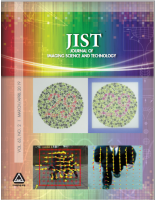
JOURNAL OF IMAGING SCIENCE AND TECHNOLOGY
Connecting Scholars in the World of ImagingJOURNAL OF IMAGING SCIENCE AND TECHNOLOGY, published by I S & T - SOC IMAGING SCIENCE TECHNOLOGY, is a pivotal resource in the realms of imaging science, optics, and materials. With its ISSN 1062-3701 and E-ISSN 1943-3522, this journal has been disseminating influential research since 1993 and continues to be a vital platform for scholars up to 2024. Despite its varied quartile rankings across disciplines—such as Q4 in Atomic and Molecular Physics and Optics, and Q3 in Chemistry (Miscellaneous) and Electronic, Optical and Magnetic Materials—it provides an essential forum for innovative ideas and advancements. The journal’s focus on interdisciplinary connections encourages collaboration among researchers in the fields of chemistry, computer science, and physics. Researchers, professionals, and students interested in exploring the latest imaging technologies and methodologies will find invaluable insights within its pages, making it a significant addition to their academic libraries.
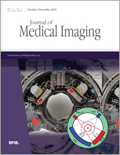
Journal of Medical Imaging
Advancing the Future of Diagnostic ImagingThe Journal of Medical Imaging, published by SPIE-SOC PHOTO-OPTICAL INSTRUMENTATION ENGINEERS, is an esteemed publication in the field of medical imaging, playing a pivotal role in advancing the discipline since its inception in 2014. With an ISSN of 2329-4302 and an E-ISSN of 2329-4310, this journal has garnered significant recognition, evidenced by its Q2 ranking in 2023 within the critical category of Radiology, Nuclear Medicine, and Imaging. The journal is dedicated to presenting cutting-edge research and innovations that enhance diagnostic imaging techniques and methodologies, appealing to a diverse audience of researchers, professionals, and students alike. Offering valuable insights into the interplay of optics and imaging technologies, it serves as a crucial resource for fostering knowledge and collaboration in the medical community. Notably, it holds a competitive rank of #136 out of 333 in its Scopus category, placing it in the 59th percentile—a testament to its influence and relevance in ongoing medical research. Therefore, the Journal of Medical Imaging stands out as an essential platform for disseminating transformative findings and innovations in healthcare imaging.
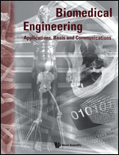
BIOMEDICAL ENGINEERING-APPLICATIONS BASIS COMMUNICATIONS
Fostering collaboration in the realm of biomedical engineering.BIOMEDICAL ENGINEERING-APPLICATIONS BASIS COMMUNICATIONS is a prominent journal dedicated to the dynamic field of biomedical engineering, published by WORLD SCIENTIFIC PUBL CO PTE LTD. Since its inception in 1992, the journal has provided a platform for the dissemination of high-quality research and innovative applications within the biomedical engineering domain. Despite its current Q4 ranking in multiple categories such as Bioengineering and Biomedical Engineering, the journal serves as an essential resource for researchers and professionals seeking to explore the latest developments and practical applications in this interdisciplinary field. The journal is based in Singapore, reflecting the region's growing influence in scientific research and technology. Although it does not offer open access, it continues to attract submissions that enrich the scientific dialogue within its community. With a commitment to fostering knowledge and research collaboration, this journal remains a vital contributor to the ongoing advancements in biomedical technology and engineering.
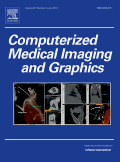
COMPUTERIZED MEDICAL IMAGING AND GRAPHICS
Elevating Standards in Medical Imaging and InformaticsCOMPUTERIZED MEDICAL IMAGING AND GRAPHICS, published by PERGAMON-ELSEVIER SCIENCE LTD, is a leading international journal that has significantly contributed to the fields of medical imaging, graphics, and informatics since its establishment in 1988. With a remarkable reputation reflected in its Q1 quartile rankings across multiple categories—including Computer Graphics, Health Informatics, and Radiology—this journal maintains a prominent position in the academic community, evidenced by its Scopus rankings where it ranks in the top percentile across various disciplines. The journal aims to advance knowledge and innovation within the intersection of technology and healthcare, featuring high-quality research that addresses contemporary challenges in medical imaging and graphical methodologies. With no open access options currently available, this journal serves as a crucial resource for researchers, professionals, and students who are at the forefront of advancing imaging technology and its applications in medicine.
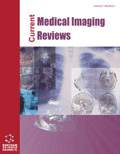
Current Medical Imaging
Connecting Research and Practice in Medical ImagingCurrent Medical Imaging is a reputable journal published by Bentham Science Publishers, specializing in the dynamic field of medical imaging, with a strong emphasis on both clinical applications and technological advancements. Established in 2007, the journal has made significant contributions to the fields of Internal Medicine and Radiology, consistently ranking in the Q3 quartile for these categories as of 2023. The journal's ISSN 1573-4056 and E-ISSN 1875-6603 ensure wide accessibility for scholarly communication, although it operates under a traditional access model. With its continuous publication from 2011 to 2024, Current Medical Imaging aims to bridge the gap between advanced imaging techniques and their practical application in patient care, making it indispensable for researchers, healthcare professionals, and students eager to stay at the forefront of innovations in imaging technology and clinical practice.

JOURNAL OF DIGITAL IMAGING
Transforming Insights into Digital Imaging ExcellenceJOURNAL OF DIGITAL IMAGING, published by Springer, is a premier journal dedicated to the field of digital imaging, encompassing significant developments in the intersecting disciplines of radiology, computer science applications, and ultrasound technology. With its impressive Q1 ranking in the categories of Radiology, Nuclear Medicine and Imaging, and Radiological and Ultrasound Technology, and a substantial Q2 ranking in Computer Science Applications, this journal is positioned at the forefront of research dissemination in these vital areas. The ISSN 0897-1889 and E-ISSN 1618-727X signify its broad reach and accessibility, while its Scopus rankings demonstrate its robust impact in the academic community, ranked #41/333 in Radiology and earning a notable 87th percentile status. Since its inception in 1988, the journal has served as a vital resource for researchers and professionals seeking to advance their understanding of digital imaging technologies and their applications. Although it does not currently offer open access options, it continues to foster scholarly dialogue and innovation, making it an indispensable platform for those committed to excellence in imaging science and technology.
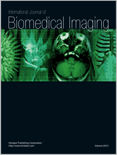
International Journal of Biomedical Imaging
Pioneering the Future of Imaging TechnologiesInternational Journal of Biomedical Imaging, published by HINDAWI LTD, stands as a pivotal resource in the field of biomedical imaging, bridging the gap between technological innovation and clinical application. Since its inception in 2006 as an Open Access journal, it has become accessible to a global audience, facilitating research dissemination and collaboration. The journal has garnered recognition within the academic community, achieving a notable Q2 category ranking in Radiology, Nuclear Medicine, and Imaging, with an impressive Scopus rank of 16 out of 333, placing it in the 95th percentile of its field. With coverage from 2006 to 2024, the journal encompasses a broad spectrum of studies focused on advancements in imaging technologies, methodologies, and clinical applications, making it an indispensable source for researchers, professionals, and students eager to stay at the forefront of biomedical imaging innovation.
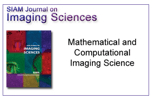
SIAM Journal on Imaging Sciences
Advancing the Frontiers of Imaging Science.SIAM Journal on Imaging Sciences is a prestigious academic journal published by SIAM PUBLICATIONS, focusing on the latest advancements and applications in imaging sciences within the fields of applied and general mathematics. Since its inception in 2008, the journal has established itself as a premier outlet for original research, evidenced by its remarkable standing in the academic community, including a Q1 ranking in both Applied Mathematics and Mathematics (miscellaneous) for 2023. With a Scopus rank of #45 in General Mathematics and an 88th percentile achievement, the journal continues to attract high-quality contributions, making it a vital resource for researchers, professionals, and students eager to stay at the forefront of imaging science developments. Although not currently open access, the journal provides significant visibility through its rigorous peer-review process and commitment to scholarly excellence, ensuring that published works contribute substantially to knowledge in the field. For those looking to delve into innovative imaging techniques or mathematical modeling approaches, the SIAM Journal on Imaging Sciences remains an essential reference point.

Image Processing On Line
Advancing the frontiers of image processing research.Image Processing On Line (ISSN: 2105-1232, E-ISSN: 2105-1232) is a pioneering open-access journal published by IMAGE PROCESSING ONLINE-IPOL since 2011, dedicated to advancing the field of image processing through the dissemination of high-quality research and innovative methodologies. Based in France, the journal serves as a platform for researchers, professionals, and students to share insights and breakthroughs in the rapidly evolving domains of Signal Processing and Software. With its current ranking as Q4 in both categories according to the 2023 category quartiles, and a Scopus ranking highlighting its significance within the computer science field, the journal is focused on nurturing contributions that push the boundaries of image processing techniques. Accessible to a global audience, Image Processing On Line is crucial for those engaged in both theoretical explorations and practical applications, ensuring a collaborative repository of knowledge that fosters innovation and development in this vital area of technology.